parking brake Acura CL 2002 Owner's Manual
[x] Cancel search | Manufacturer: ACURA, Model Year: 2002, Model line: CL, Model: Acura CL 2002Pages: 335
Page 54 of 335
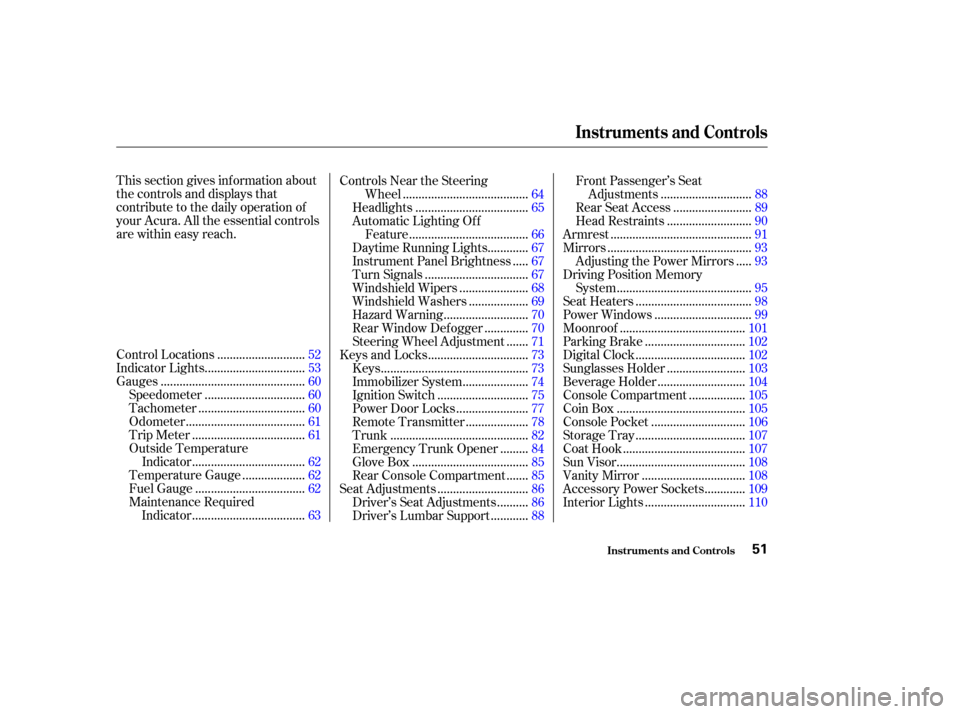
This section gives inf ormation about
the controls and displays that
contribute to the daily operation of
your Acura. All the essential controls
are within easy reach............................
Control Locations .52
...............................
Indicator Lights .53
.............................................
Gauges .60
...............................
Speedometer .60
.................................
Tachometer .60
.....................................
Odometer .61
...................................
Trip Meter .61
Outside Temperature ...................................
Indicator .62
...................
Temperature Gauge . 62
..................................
Fuel Gauge .62
Maintenance Required ...................................
Indicator .63 Controls Near the Steering
.......................................
Wheel .64
...................................
Headlights .65
Automatic Lighting Off .....................................
Feature .66
............
Daytime Running Lights . 67
....
Instrument Panel Brightness . 67
................................
Turn Signals .67
.....................
Windshield Wipers .68
..................
Windshield Washers . 69
..........................
Hazard Warning .70
.............
Rear Window Def ogger . 70
......
Steering Wheel Adjustment . 71
...............................
Keys and Locks .73
..............................................
Keys .73
....................
Immobilizer System . 74
............................
Ignition Switch .75
......................
Power Door Locks .77
...................
Remote Transmitter . 78
...........................................
Trunk .82
........
Emergency Trunk Opener . 84
....................................
Glove Box .85
......
Rear Console Compartment . 85
............................
Seat Adjustments .86
.........
Driver’s Seat Adjustments . 86
...........
Driver’s Lumbar Support . 88Front Passenger’s Seat
............................
Adjustments .88
........................
Rear Seat Access .89
..........................
Head Restraints .90
............................................
Armrest .91
.............................................
Mirrors .93
....
Adjusting the Power Mirrors . 93
Driving Position Memory ..........................................
System .95
....................................
Seat Heaters .98
..............................
Power Windows .99
.......................................
Moonroof .101
...............................
Parking Brake .102
..................................
Digital Clock .102
........................
Sunglasses Holder .103
...........................
Beverage Holder .104
.................
Console Compartment . 105
........................................
Coin Box .105
.............................
Console Pocket .106
..................................
Storage Tray .107
......................................
Coat Hook .107
........................................
Sun Visor .108
................................
Vanity Mirror .108
............
Accessory Power Sockets . 109
...............................
Interior Lights .110
Instruments and Controls
Inst rument s and Cont rols51
Page 58 of 335

This light has two f unctions:This indicator comes on when you
turn the ignition switch ON (II). It
is a reminder to check the parking
brake. Driving with the parking
brake not f ully released can
damage the brakes and tires.
If the indicator remains lit after
you have f ully released the
parking brake while the engine is
running, or if it comes on while
driving, it can indicate a problem
in the brake system. For complete
inf ormation, see page .
The engine can be severely damaged
if this light f lashes or stays on when
the engine is running. For complete
inf ormation, see page .
If this light comes on when the
engine is running, the battery is not
being charged. For complete
inf ormation, see page .
See page .
The instrument panel has many
indicators to give you important
inf ormation about your car.
This indicator lights when you turn
the ignition switch ON (II). It is a
reminder to you and your passengers
to protect yourselves by f astening
the seat belts. A beeper also sounds
if you have not fastened your seat
belt.
If you do not f asten your seat belt,
the beeper will stop af ter a f ew
seconds but the light stays on until
you do. Both the light and the beeper
stay of f if you f asten your seat belt
bef ore turning on the ignition.
1.
2.
292
288
289
290
Indicator L ights
Inst rument s and Cont rols
Parking Brake and Brake System
Indicator
L ow Oil Pressure
Indicator
Charging System
Indicator
Malf unction Indicator
Lamp
Seat Belt Reminder L ight
55
U.S. Canada
Page 61 of 335

This light comes on with the high
beam headlights. See page for
inf ormation on the headlight
controls.
On Canadian models, this indicator
comes on with reduced brightness
when the Daytime Running Lights
(DRL) are on (see page ).
This indicator lights when you turn
the ignition switch to ON (II) with
the headlight switch of f and the
parking brake set. It should go of f if
youturnontheheadlightsorrelease
the parking brake. If it comes on at
any other time, it means there is a
problem with the DRL. There may
also be a problem with the high
beam headlights.
The lef t or right turn signal light
blinks when you signal a lane change
or turn. If the light does not blink or
blinks rapidly, it usually means one
of the turn signal bulbs is burned out
(see page ). Replace the bulb as
soon as possible, since other drivers
cannot see that you are signalling.
WhenyouturnontheHazard
Warning switch, both turn signal
lights blink. All turn signals on the
outside of the car should f lash.
The appropriate light comes on in
this display if the trunk or either
door is not closed tightly with the
ignition switch ON (II). 65
67
257
Canadian models only
High Beam Indicator
‘‘Daytime Running
Lights’’ Indicator
Turn Signal and
Hazard Warning
Indicators
Door and T runk Open Monitor
Indicator L ights
Inst rument s and Cont rols58
Page 70 of 335
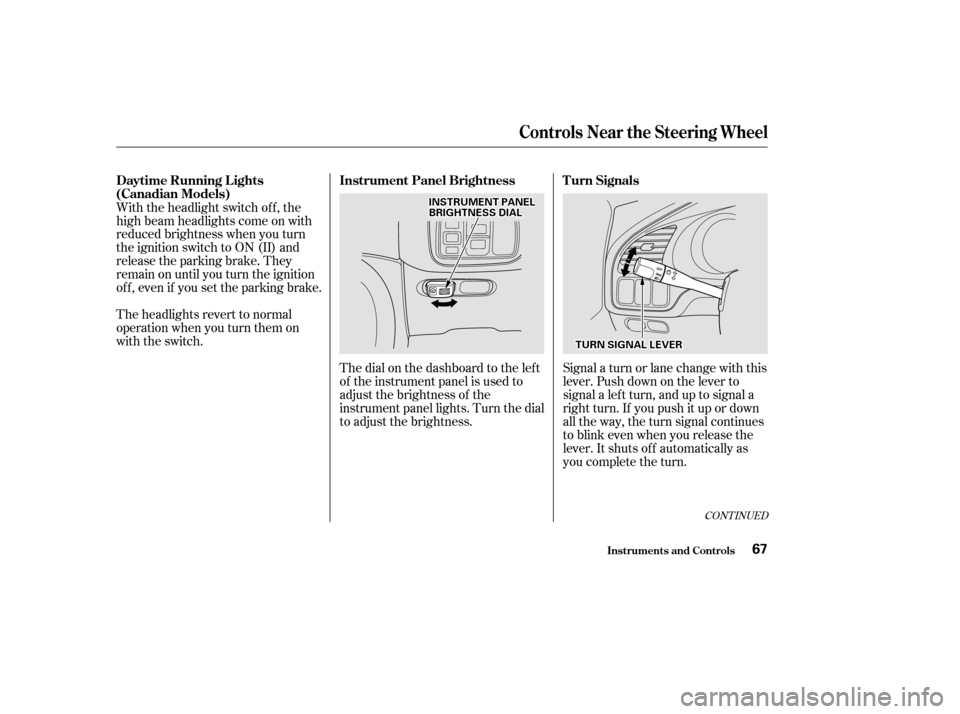
Signal a turn or lane change with this
lever. Push down on the lever to
signal a lef t turn, and up to signal a
right turn. If you push it up or down
all the way, the turn signal continues
to blink even when you release the
lever. It shuts off automatically as
you complete the turn.
With the headlight switch off, the
high beam headlights come on with
reduced brightness when you turn
the ignition switch to ON (II) and
release the parking brake. They
remain on until you turn the ignition
of f , even if you set the parking brake.
The headlights revert to normal
operation when you turn them on
with the switch.
The dial on the dashboard to the lef t
of the instrument panel is used to
adjust the brightness of the
instrument panel lights. Turn the dial
to adjust the brightness.
CONT INUED
Turn Signals
Instrument Panel Brightness
Daytime Running L ights
(Canadian Models)
Controls Near the Steering Wheel
Inst rument s and Cont rols67
I IN NS STTR
RU UM M E
EN
NT T P
PA
A N
NE EL
L
B
BR RIIGGH HT
TN
NE ES
SS S D
DI
IAA L
L
T
TU
UR RNN S
SIIGGN NAAL
L L
LEE V
V E
ER
R
Page 99 of 335
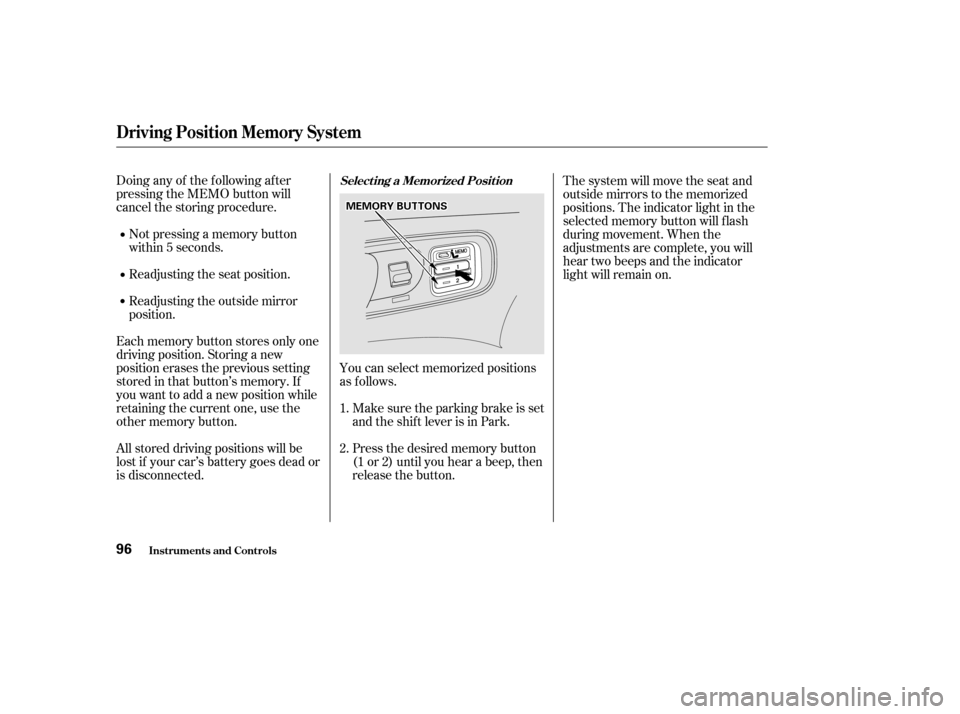
Doing any of the f ollowing af ter
pressing the MEMO button will
cancel the storing procedure.Not pressing a memory button
within 5 seconds.
You can select memorized positions
as f ollows.Make sure the parking brake is set
and the shif t lever is in Park.
Readjusting the seat position.
Press the desired memory button
(1 or 2) until you hear a beep, then
release the button.The system will move the seat and
outside mirrors to the memorized
positions. The indicator light in the
selected memory button will f lash
during movement. When the
adjustments are complete, you will
hear two beeps and the indicator
light will remain on.
Readjusting the outside mirror
position.
Each memory button stores only one
driving position. Storing a new
position erases the previous setting
stored in that button’s memory. If
you want to add a new position while
retaining the current one, use the
other memory button.
All stored driving positions will be
lost if your car’s battery goes dead or
is disconnected. 1.
2.Select ing a Memorized Posit ion
Driving Posit ion Memory Syst em
Inst rument s and Cont rols96
M M
E
EM
M O
ORRYY B
BUUT TT
TO
ON NSS
Page 105 of 335
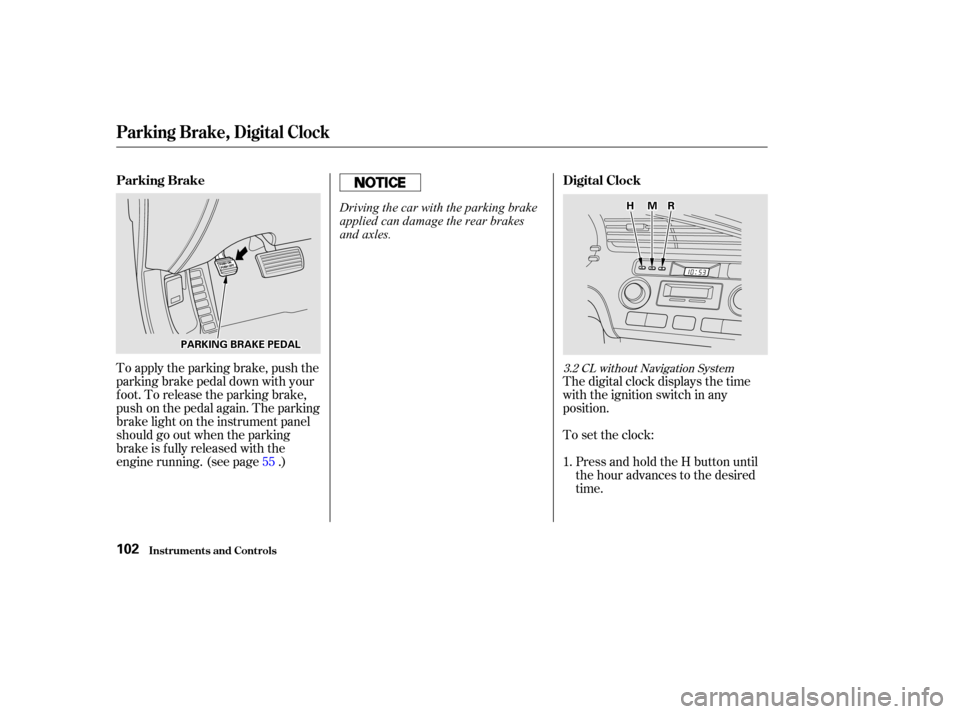
To apply the parking brake, push the
parking brake pedal down with your
f oot. To release the parking brake,
push on the pedal again. The parking
brake light on the instrument panel
should go out when the parking
brake is f ully released with the
engine running. (see page .)The digital clock displays the time
with the ignition switch in any
position.
To set the clock:
Press and hold the H button until
the hour advances to the desired
time.
1.
553.2 CL without Navigation System
Parking Brake Digital Clock
Parking Brake, Digital Clock
Inst rument s and Cont rols102
P PA
A R
RKKIINNG G B
BRRAA K
KEE P
PE
ED
D A
AL
L H
H
M
MR
R
Driving the car with the parking brake
applied can damage the rear brakes
and axles.
Page 167 of 335

Shift to Park or Neutral and set
the parking brake. Pull the hood
release handle located under the
lower lef t corner of the dashboard.
The hood will pop up slightly.
Screw the f uel f ill cap back on,
tighten it until it clicks several
times. If you do not properly
tighten the cap, the Malfunction
Indicator Lamp may come on (see
page ).
Push the f uel f ill door closed until
it latches.
Standing in f ront of the car, reach
in between the hood and the f ront
bumper with your f inger. The
hood latch handle is under the ‘‘A’’
logo. Slide the latch handle to the
right.
1.
2.
5.
6.
290
Service Station Procedures
Bef ore Driving
Opening the Hood
164
H H
O
OO ODD R
REEL
LEE A
A S
SEE H
HA
AN
ND DL
LEE
L
LAA T
TC
CH H H
HA
AN
ND DL
LEE
Page 178 of 335

This section gives you tips on
starting the engine under various
conditions, and how to operate the
automatic transmission. It also
includes important inf ormation on
parking your car, the braking system,
the Traction Control System, the
Vehicle Stability Assist System, and
f acts you need if you are planning to
tow a trailer.........................
Preparing to Drive .176
.......................
Starting the Engine .177
Starting in Cold Weather ....................
at High Altitude .177
..............
Automatic Transmission . 178
.
Shif t Lever Position Indicator . 178
................
Shif t Lever Positions . 179
..............
Engine Speed Limiter . 184
....................
Shif t Lock Release . 185
...........................................
Parking .186
.....................
The Braking System .187
.............
Brake Wear Indicators . 187
...............
Brake System Design . 188
.......................
Anti-lock Brakes .188
Important Saf ety .........................
Reminders .189
........................
ABS Indicator .189
..............
Traction Control System . 190
...
Vehicle Stability Assist System . 193
...............
Driving in Bad Weather . 196
...........................
Towing a Trailer .198
Driving
Driving175
Page 180 of 335

Push the accelerator pedal half-
way to the f loor and hold it there
while starting the engine. Do not
hold the ignition key in START
(III) f or more than 15 seconds.
When the engine starts, release
the accelerator pedal gradually as
the engine speeds up and smooths
out.
If the engine fails to start in step 2,
push the accelerator pedal to the
f loor and hold it there while you
try to start the engine for no more
than 15 seconds. If the engine
does not start, return to step 2.
If the engine still does not start,
press the accelerator pedal all the
way down and hold it there while
starting in order to clear f looding.
As bef ore, keep the ignition key in
the START (III) position f or no
more than 15 seconds. Return to
step 5 if the engine does not start.
If it starts, lif t your f oot of f the
accelerator pedal so the engine
does not race.
An engine is harder to start in cold
weather. The thinner air f ound at
high altitude above 8,000 f eet (2,400
meters) adds to the problem.
Use the f ollowing procedure: Turn of f all electrical accessories
to reduce the drain on the battery.
Apply the parking brake.
In cold weather, turn of f all
electrical accessories to reduce
the drain on the battery.
Make sure the shif t lever is in
Park. Press on the brake pedal.
Without touching the accelerator
pedal, turn the ignition key to the
START (III) position. If the engine
does not start right away, do not
hold the key in START (III) f or
more than 15 seconds at a time.
Pause f or at least 10 seconds
bef ore trying again.
If the engine does not start within
15 seconds, or starts but stalls
right away, repeat step 4 with the
accelerator pedal pressed half-way
down. If the engine starts, release
pressure on the accelerator pedal
so the engine does not race.
1.
2.
3.
4.
5.
6.
1.2.
3.
Starting in Cold Weather at High
A ltitude (A bove 8,000 f eet/
2,400 meters)
Driving
Starting the Engine
177
Page 188 of 335
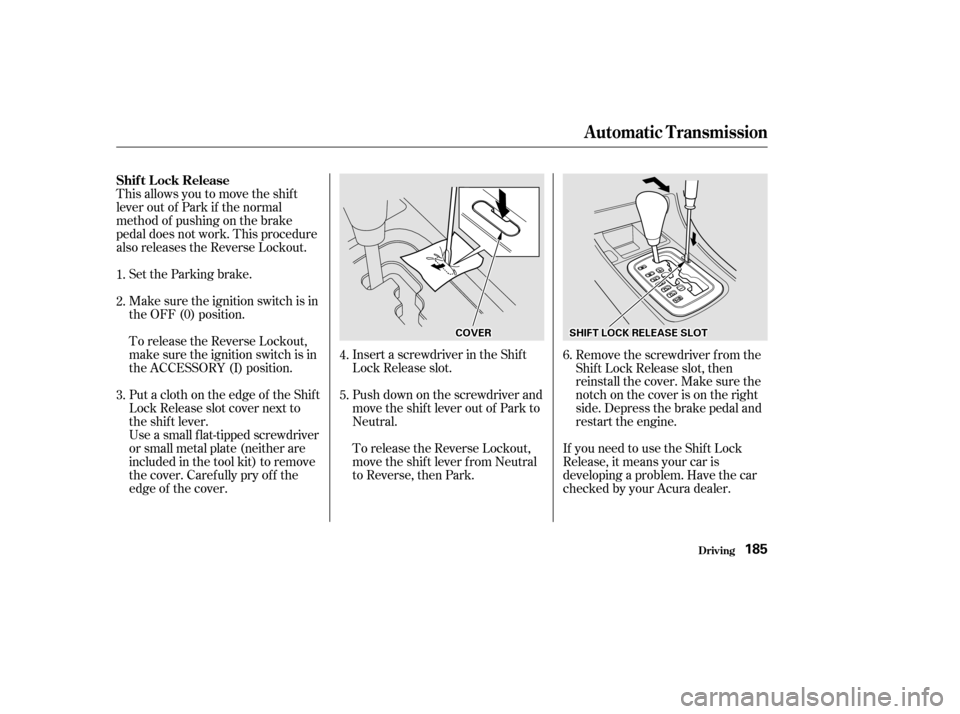
If you need to use the Shif t Lock
Release, it means your car is
developing a problem. Have the car
checked by your Acura dealer.
This allows you to move the shif t
lever out of Park if the normal
method of pushing on the brake
pedal does not work. This procedure
also releases the Reverse Lockout.
Set the Parking brake.
Make sure the ignition switch is in
the OFF (0) position.
To release the Reverse Lockout,
make sure the ignition switch is in
the ACCESSORY (I) position.
Put a cloth on the edge of the Shif t
Lock Release slot cover next to
the shift lever.
Use a small flat-tipped screwdriver
or small metal plate (neither are
included in the tool kit) to remove
the cover. Caref ully pry of f the
edge of the cover. Insert a screwdriver in the Shif t
Lock Release slot.
Push down on the screwdriver and
move the shift lever out of Park to
Neutral.
To release the Reverse Lockout,
move the shift lever from Neutral
to Reverse, then Park.
Remove the screwdriver f rom the
Shif t Lock Release slot, then
reinstall the cover. Make sure the
notchonthecoverisontheright
side. Depress the brake pedal and
restart the engine.
1.
2.
3.
4.
5.6.
Driving
Automatic Transmission
Shif t L ock Release
185
S SH
H I
IFFT T L
LOOC CKK R
REEL
LEE A
A S
SEE S
SLLOOT T
C
CO OV VE
ER
R